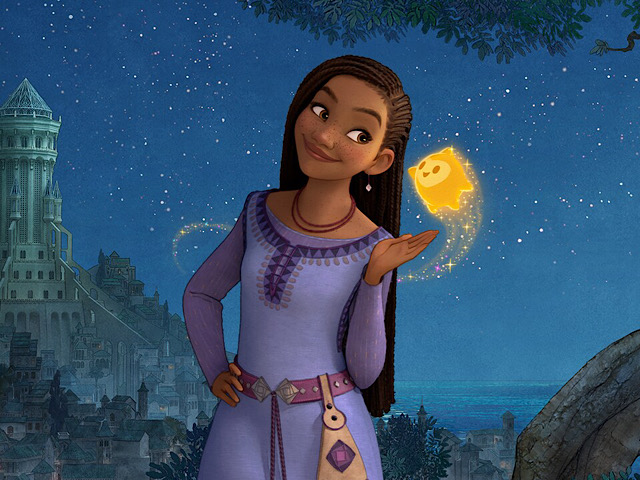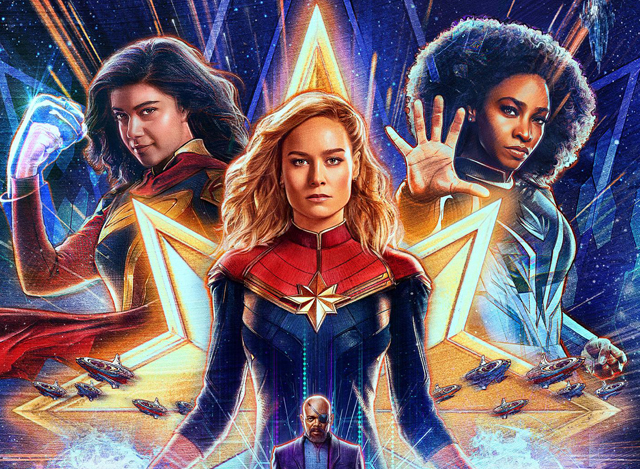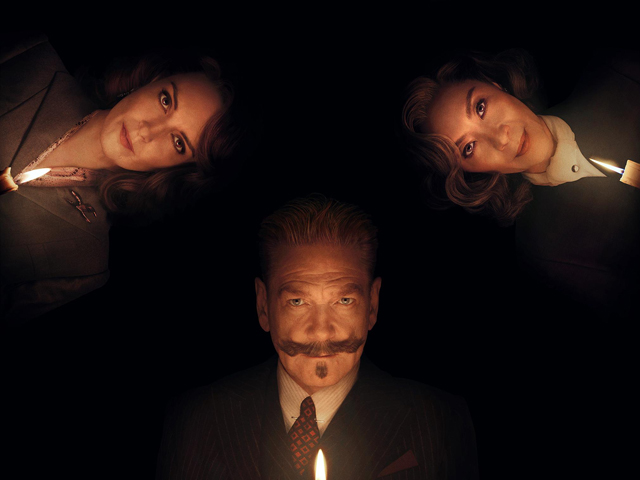
The once resilient comic book movie genre that dominated the box office in the 2010’s has had a rough time of it lately. It’s no longer just the reliable moneymaker that it once was, and it’s a problem that is growing increasingly problematic across the whole industry. It’s even affected the undisputed champ of the genre, Marvel Studios, who suffered their own worst year in a long while in 2023. The problem is not so much the characters or the stories that are being told on screen, but the fact that the productions of these movies have become so over bloated and the market has been over-saturated to the point where box office revenue can no longer cover the costs of making the movies. There are still some bright spots, as movies like Spider-Man: Across the Spider-Verse (2023) and Guardians of the Galaxy Vol. 3 (2023) still managed to check off a box office victory, but overall audiences have made it clear that they are growing tired with a genre that looks to be well past it’s peak. The studios seem to be getting the message at the moment, as both Marvel and DC have pulled back on their production slate in order to reassess their upcoming futures. Marvel Studios only has one theatrical release in the whole of 2024, with Deadpool & Wolverine coming in the Summer, while DC is working on a full reboot of their Cinematic Universe starting in 2025. And it’s probably a good thing for both them and the audiences that we’ll have a bit of breathing room that will help us to fall in love with the genre once again. It’s too bad that Sony Pictures and their licensed Spider-Man Universe didn’t get that same memo. If there was any hope for a comic book lite year at the movies, it’s been dashed with Sony’s onslaught of new films that are already built on a flimsy foundation of what Sony considers to be a cinematic universe.
Since the turn of the millennium, Sony has retained the cinematic rights to the character Spider-Man and his affiliated cast of friends and rogues; a result of Marvel’s then plan to spread their characters around to all interested parties around Hollywood. As Marvel began to reconsolidate it’s cinematic rights into a singular studio, with the help of parent company Disney, Spider-Man remained the sole holdout purely because Sony continued to have box office success with every film. They believed that if they continued to release a new Spider-Man affiliated movie every year, their rights to the character would remain intact and they could sustain a franchise on it’s own without having to relinquish it back to Marvel. The plan, however, hit some speedbumps as The Amazing Spider-Man reboot of the franchise didn’t have the strongest legs. In order to keep the rights in house, the set up a special deal with Disney where the Spider-Man character could participate in the mega-successful MCU while Sony would continue to produce the standalone Spider-Man films in conjunction. Marvel was thrilled that they could have a say in the cinematic representation of their A-list hero again, and Sony could now benefit from the exposure that could spill over into their own movies. While this arrangement was happening, Sony also looked for other ways to maintain their hold onto the Spider-Man rights, and they believed the best way to do that was to build up a cinematic universe of their own; not just centered on Spider-Man, but all the characters in his orbit too. Soon, famous spider-foe Venom received his own solo film, which itself turned into a surprise success, thanks to the star power of Tom Hardy in the role. After this, movies based on other Spider-Man linked characters emerged, including a movie for Dr. Michael Morbius and Kraven the Hunter. This hope for a Spider-Verse seemed short lived however, as the Morbius (2022) movie opened to dismal box office and terrible critical reviews. Right now, despite early success with Venom, the Sony Spider-Verse is looking very much like the poster child for everything that’s wrong with the super hero genre right now, and things don’t any brighter as Sony is premiering a film this week centered around one of the truly most obscure characters in the Spider-Man storyline; the mysterious Madame Web.
The movie follows the story of New York City based EMT Cassandra Webb (Dakota Johnson). She spends most of her day saving as many lives as she can alongside her fellow ambulance driver and friend Ben Parker (Adam Scott). On a routine assignment helping out victims of a factory explosion, she starts to have peculiar visions; almost like time slipping backwards and forwards without warning. She soon learns that some of her visions end up coming true, which becomes an alarming revelation for her. As she heads home from a psychiatric exam, she has her most troubling vision yet. She witnesses three girls aboard her commuter train getting assaulted by a mysterious man. As she regains her composure, she alerts the three girls and guides them away from the man who is pursuing them. After a chase through the city, Cassandra manages to find a hiding place, and she tries desperately to explain the very peculiar situation to the three frightened teens. She quickly learns that each of the girls have actually interacted with her in the past couple of days, right before the visions manifested. Julia Cornwall (Sydney Sweeney) was the step-daughter of a victim that Cassandra helped deliver to the hospital. Mattie Franklin (Celeste O’Connor) was nearly run into by Cassandra’s ambulance on the same run. And Anya Corazon (Isabela Merced) lives in the same building as Cassandra. All of them are somehow linked together by what seems like chance, but Cassandra believes there might be more answers elsewhere. She decides to consult the journal written by her mother, the one thing she has from her as her mom died during child birth, leaving her an orphan. In her journal, Cassandra finds a photograph of the man that was trying to hunt after her and the girls earlier; a rich tycoon named Ezekiel Sims (Tahar Rahim), who was after a source of power that comes from a certain Spider species deep in the Amazon jungle. It turns out that Ezekiel and Cassandra’s powers of foresight are linked, as Ezekiel has had visions of his own of his life ending at the hands of the three teenage girls, who themselves will be bestowed with powers in the future. Does Cassandra manage to gain control of her special ability and help save the future heroes, or will Ezekiel manage to undo his own fate by destroying the lives of these girls in a time when they still have no idea what is happening?
My own experience with the Sony Spider-Verse has been fairly mixed. Excusing the animated Spider-Verse movies, which are definitely separate from the live action productions (and might I add also much better movies), the overall value of Sony’s films is a far cry from what’s been put out by Marvel Studios itself. I for one didn’t mind the first Venom (2018), which while not a great movie was nevertheless helped greatly by a winning performance by Tom Hardy as the titular anti-hero. Morbius was very much a mess of a movie, though I didn’t have the same hatred for it as most other people do. It was bad, don’t get me wrong, but I’ve seen much worse movies and Morbius was just boring for the most part, with Matt Smith’s vampy villainous turn being the one bright spot. Now we have Madame Web, which seems even more superfluous than a Morbius film, and the timing for it couldn’t be worse as it seems the super hero fanbase is drying up. It is possible that a movie like Madame Web could overcome these roadblocks to stand on it’s own as an engaging action thriller. Unfortunately, this movie has ended up being exactly what we expected it to be, and honestly even worse than that. This movie is the worst Sony Spider-Verse film thus far, and it’s not even close. Morbius had some redeemable moments by being entertainingly bad at times. Madame Web is a movie devoid of any entertainment value. It isn’t even the fun kind of bad. This was without a doubt one of the most difficult sit throughs of a movie that I have had in a long time; almost reaching Dear Evan Hansen (2021) levels of discomfort. At a time where the super hero genre desperately needs to win back goodwill with it’s audience, this movie is unfortunately going to remind everyone of all the bad things about the genre, because this movie is full of every single one.
I honestly don’t know where the genesis of all the problems with this movie lie. The script is certainly one of the worst factors. Remarkably, Sony decided to go with the same team of writers that had written Morbius, showing that that they learned nothing from that experience. Matt Sazama and Burk Sharpless are also the scribes responsible for such cinematic gems like Dracula Untold (2014), The Last Witch Hunter (2015), and Gods of Egypt (2016), which makes you wonder how some writers somehow manage to fail upward in the movie business. Madame Web may be their worst script left, because the whole thing reads like a first draft from someone who just completed a Screenwriting 101 course. The movie has the clunkiest expositional dialogue I have ever seen. Nobody speaks like a human being, they are just information dumps simply there to move the story forward. There’s absolutely no interesting scenes of character development. Every motivation is forced and the situations are contrived. The main character herself, Cassandra Webb, suffers the most from this. We don’t get any insight into her character, such as quirks or desires. She’s just a passive pivot point for all the events of the movie to center around. If the powers that be at Sony thought she was deserving of her own film, than make her a interesting enough to make us care. The same can be said for all the other characters as well. Ezekiel Sims is likewise also hollow as a character. We only get the most miniscule of reasons as to why he’s a villain. He’s sole purpose here is to look menacing in a Spider-Man like suit, and he fails pretty hard at even that.
The performances are also likewise pretty subpar. I don’t know what kind of direction Dakota Johnson got (if any), but her performance as Cassandra Webb is like watching a mannequin emote. There is nothing there but barely above a whisper line deliveries and the occasional eye roll. Dakota Johnson may get a bad rap based on her past work in the Fifty Shades of Gray franchise, but she is capable of strong performance, as seen in movies like Luca Guadagnino’s Suspiria (2018) and The Peanut Butter Falcon (2019). She may have had the capability of crafting a more interesting performance here, but the lack of direction just leaves her lost. That’s true of pretty much all of the leads in this film. The three teenagers lack chemistry with each other, which makes their interactions more grating than endearing. They feel even more awkward interacting with Dakota Johnson’s Cassandra, who’s supposed to be the guiding mentor to all of them, but in the end just feels like another moody teenager. Tahar Rahim doesn’t help matters much more with his performances as Ezekiel Sims. His one-note, understated performance is the blandest possible route to take with a character that’s supposed to be a terror. Honestly, his performance is better when you can’t see his face once it’s behind a mask. It doesn’t improve his performance much, but it’s better than the dead eye dour expression that makes up the rest of his performance. Honestly, the only salvageable performances in the movie are from the film’s smallest parts; that of Adam Scott as Ben Parker and Emma Roberts as Mary Parker, the future mother of Spider-Man (the movie takes place 20 years in the past by the way). They don’t add much to the overall movie, but these characters at least offer their actors a little bit of personality to hold onto, and Scott and Roberts are at least trying. That’s the big takeaway from the performances in this movie, a very big lack of trying. These actors are certainly capable of emoting, but whether it’s the lack of direction or the actors just not invested in the whole production itself, what we are left with is a movie lacking in any personality whatsoever.
Is there anything about the film that is worthwhile. The only good things I can say is that the movie does do some interesting things with the time slipping that Cassandra experiences. I did find the editing of these scenes effective, as it does a fair job of disorienting you while also making it clear how these visions appear from Cassandra’s point of view. It doesn’t do the time travel thing as well as similar sequences found in Groundhog’s Day (1993) or Edge of Tomorrow (2014), but it works just enough to give the otherwise stale action sequences a little bit more flavor. It seems like the editors were the only ones making this movie that actually did their jobs right. Otherwise, visually, this movie is another mess that ruins the experience. Some have rightly pointed out that this movie feels like a throw back to the mid-2000’s era of super hero movies, with it’s washed out color scheme and bland camera work. While there were definitely some super hero movies of that era that had that kind of look, which thankfully went out of style once the bright and colorful MCU emerged, the 2000’s still had plenty of visually impressive movies in the genre too; especially the Sam Raimi directed Spider-Man trilogy. Madame Web definitely feels like it’s a movie stuck in the past, and not in a good way. It’s only compounded more when the very generic looking visual effect appear in the climatic final act. The movie for the most part doesn’t so much feel like a super hero movie from 20 years ago, but rather an action film from 20 years ago; the kind of filmmaking that was coming out of the school of Jerry Bruckheimer. For Marvel’s sake, at least no one will mistake this kind of movie for one of their own; as they’ve been pretty good at keeping their own house style consistent and appealing. There’s nothing really offensively bad about the way that the movie looks; it’s just that Madame Web’s visual style is as devoid of character as everything else in the movie, again pointing to the whole pointless nature of it’s existence.
In many ways, this movie honestly puts the problems with Marvel and DC’s recent films in a more favorable light. As much as films like The Marvels (2023) and Aquaman and the Lost Kingdom (2023) have struggled at the box office, those movies at least tried to do something to be entertaining. I for one actually quite enjoyed The Marvels and a recent re-watch has confirmed my positive view. All of the complaints that other critics have levied at The Marvels I feel are more pronounced in the nothing burger that is Madame Web. It is by far the lowest effort super hero film I have experienced in a long time; maybe even ever. It’s astounding to see so little passion put into this kind of movie. It’s like even the actors and the filmmakers knew just how pointless this whole thing was from the get go, and they just gave up caring. There was no love put into this movie. The only reason it exists is so that Sony can extend it’s cinematic rights to the Spider-Man corner of the Marvel library. Madame Web was perhaps a stretch too far, as no one outside of the most knowledgeable comic book reader even knows of the character’s existence. And I’m sure even that kind of devoted fan will be angered by the butchering of Madame Web as a character in this movie. It’s likely that Sony’s going to learn a lesson from this experience, as the film is very clearly going to bomb, even harder than Morbius did. It’s hard to say if there was any valuable reason why this movie should exist at all. If someone put their heart into it and had a worthwhile story to tell, then it’s certainly possible. But, Madame Web is far from that movie and another example of Sony missing the mark when it comes to building a cinematic universe in the vein of the MCU. I don’t know if I would say it’s the worst comic book movie ever made, since we do live in a world where Fant4stic (2015) still exists, but it certainly feels like the most pointless super hero movie ever made. And in the end, the Sony Spider-Verse has found itself caught in a web of destruction that I don’t see them ever finding a way of escaping; except solely through animation.
Rating: 3/10








